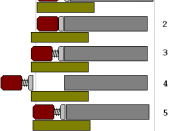Gravitational and Inertial Mass Lab Last week in physics we had a new lab. The Gravitational and Inertial Mass Lab. In this lab we learned many new terms such as, mass (gravitational and inertial), Inertia, Kilogram, Inertial Balance, and Period of Vibration. Gravitational mass is the amount of mass you have told by the force of gravity pulling the mass toward the center of the gravity. Inertial mass is the amount of force to move an object without gravity. Inertia is the ability of an object to stay still or in motion. Kilogram or kg, 1 kg is 1000 grams. Inertial Balance is a machine used to measure the amount of mass in an about by its inertia. Period of Vibration or p is measured in time divided by the # of times, and it's the times it takes to go out and back one time.
In this lab, we were also introduced into some new instruments such as the 4-beam Balance, and the Inertial Balance.
The 4-beam Balance is handled by the base and the column of the machine when moved or picked up, when calibrating make sure all waits are at zero then make sure pointer is on zero or the line if its not adjust the nut till the pointer is at the line or zero. You read the machine in grams, each digit in the machine means a separate thing, the 4th digit is a kilogram (kg), the 3rd digit is hectograms (hg), the 2nd digits are decagrams the 1st digit is grams, this digit here .1g is a decigram. This instrument has an uncertainty of about .05g, which is 5 centigrams. The next instrument was the Inertial Balance, you use it by placing a mass into the bucket or barrel and pulling back the contraption to a certain point and timing the amount of time it takes to leave and go back to that point. The Instrument all depends on how far you pull it back so make sure you measure to the exact point you pulled it back when looking for the time lapse. The machine is really actually measuring how much inertia the mass has by measuring the time it takes to stop the object in motion and pull it back to the starting point and so on.
There were three graphs that we created with our data. Our first graph was the number of paper clips to the mass of them, the number being the dependent and the mass being the independent. In this graphs we got a tangent line in the positive direction, this basically means when you raise the mass you must raise the number paper clips to fit that mass. Graph two was of our known masses verses the period of them. We concluded our graph to be half of a parabola. When you get a half parabola for a graph, it usually means that you get an increase or decrease in independent you get an even higher increase or lower decrease than the last dependent, in this case it was for every increase in period you got a higher increase than the last increase in mass. The third graph we got was the same as the second except we squared the period and graphed it. We ended up with a half parabola again, but this half parabola was a little more spread out and easier to see the linear regression, or linear average of the points.
To go with the lab our teacher gave and showed us many demonstrations. The first demonstration our teacher showed us was him pulling out a sheet of paper out from underneath a mass. I saw the mass stay where it was without moving at all, this happened because of the masses inertia was strong enough to allow the piece of paper to slip out from underneath it with out moving the mass. In the second demonstration we were shown a video tape of someone pulling out a piece of material, which was above a glass of water, and having a egg placed on top of an egg holder, which is on top of the piece of material, then the egg holder is propelled outward and the egg falls into the glass of water without breaking. Now the egg holder was propelled outward because of its inertia was to little to hold itself in place when the material was pulled out. The egg fell into the water because the egg holders absorbed most of the force allowing the egg to receive minimum force of movement except the force of gravity, which is straight down. The third demonstration was of a man out in the Sky Lab, which used to be in space where no gravity is present, on an inertial balance figuring out his mass with out gravity present, this did exactly what it would have done on earth in the presence of gravity.
Now that I've told a little bit about our lab let me clear up some questions you might be having. What is the difference between gravitational and inertial mass? Well, gravitational mass is the mass determined by the force of gravity pulling an object of mass down toward the center of gravity. Inertial gravity is determined by the amount of force it takes to make an object with mass, which is stationary move, or an object of mass moving in a straight-line move in a different direction. What are the units of mass in the metric and English system, and what are the units of force in the metric and English system? Mass in metric is kilograms and in the English its slugs. Force in the metric system is newtons and in the English system its pounds. What is the difference between mass and weight? Mass is how much of something you have in a certain object, and weight is how much gravity is pulling on the mass you have, it is a force. Would a 4-beam Balance work on the moon, or in outer space? On the moon the balance would work for the moon has gravity also yet on the moon you get less force or weight because there is less gravity there, in outer space it would not work for the is no gravity in outer space. Would the Inertial Balance work on the moon or in outer space? The balance would work on both, because it is not looking for a force, unlike the 4-beam balance, its looking for a mass which will always be there. Newton's first law of motion: An object will stay at rest or stay in motion at a constant velocity in a straight line unless acted upon by an outside unbalance force. This is stating that an objects inertia will keep it from moving from the coarse it was taking, whether it was staying still or moving, the only way it will move from its coarse is if the object is acted on by an outside force such as gravity or kinetic force or other forces unbalanced.




